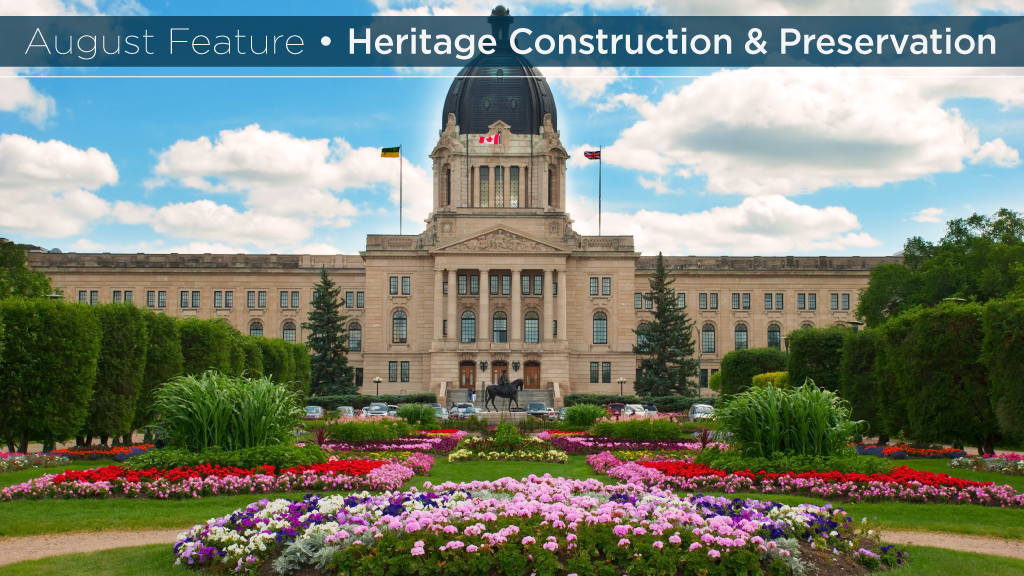Evolving construction and engineering technology will play a key role in preserving Canada’s heritage buildings in the face of deterioration and a changing climate, says a Saskatchewan structural engineer who specializes in conserving old structures.
“That is the history of building construction and engineering — how is that building performing and how can we make it better?” said Brad Taylor of JCK Engineering in Regina, who believes the construction industry has the resources and ingenuity to rise to the challenges.
For over a decade, Taylor has held a special interest in building heritage conservation and restoration and in 2022 was honoured by the Canadian Association of Heritage Professionals for the work on restoring the 1929 Darke Hall, a Regina performance hall.
He has also worked on the Claybank Brick Plant National Historic Site, which supplied brick to Cape Canaveral launch pads, as well as Saskatchewan’s Legislative building, the College Avenue Campus Renewal Project in Regina as well as the Yorkton Heritage Flour Mill.
For things to endure, said Taylor, heritage structures need to be maintained and assessments going forward to meeting changing site and environmental conditions.
“Every building is different,” he said, adding maintenance is no different than that done on a home, car or one’s personal health.
The change could be building deterioration leading to repairs, site instability or traumatic events.
He points to what is being called the 100-year-old “miracle house” in Lahaina on Maui, a newly renovated heritage home that remained standing while the neighbourhood was reduced to ashes.
While the home’s renovation was not designed for fire, its metal roof and rock guards (for termites) contributed to its salvation. Taylor said conservationists can learn from this house.
Foundations are pivotal to any conservation effort on heritage buildings.
“We would start with the foundation and that is where a lot of cost comes in, repairing the foundation. Understanding the foundations is our first stop,” he said as it will have to support restoration internally but also external forces upon the structure.
Foundations also show how building technology has evolved, according to Taylor, whose expertise is in structural assessment and analysis of masonry, stone concrete and timber structures.
They offer an opportunity to learn about the building’s history but also building practices and materials, their historical and future performances.
Eastern and European builders often built to the conditions they were used to.
Taylor has found shallow footings or footings at grade, both of which would not be considered adequate today.
Saskatchewan’s clay soil absorbs and expands leading to site instability. But, as larger structures were built, Taylor said it is possible to see how technological solutions emerged such as inverted arch foundations. Where work is done today to strengthen a foundation, it can often involve some form of under-pinning to deal with soil conditions.
Northern Saskatchewan’s 1888 Stone Church Cemetery, a Canadian heritage structure, is the oldest structure that Taylor has worked on. With a shallow foundation “one corner had started to settle,” said Taylor.
While the whole foundation needed addressing, costs limited efforts to a new footing for that wall as the church’s congregation was small.
The fieldstone wall was taken apart, the stones catalogued and laid out as they were in the wall, and then reconstructed to preserve the heritage value of the structure.
A mason did the work on the wall.
“The stone was put back in place as close as possible,” said Taylor, adding forming good partnerships with masons and other crafts is important when attempting to restore a structure.
Cost is often a major hurdle and the inability to provide maintenance puts a building at risk if the restoration cost eventually becomes insurmountable. This is common in churches as members are aging out and there is not the donor base to upkeep the structure. The challenge is then preserving some record of structures that can’t be saved.
“I think it is important that we maintain our knowledge of these (historic) buildings,” said Taylor.
CyArk, a non-profit organization, can play a role. CyArk has pioneered 3D recording technologies for the preservation and celebration of cultural heritage and has worked at over 200 sites in more than 40 countries.
Taylor said two organizations, the Canadian Association of Heritage Professionals and the Association of Preservation Technology International group, are strong resources with member expertise.
Just as those building heritage buildings in the past used their best knowledge, engineers are today, through such associations, looking at solutions in preserving Canada’s historical structures.
“We are always evolving to meet the challenges that are arising,” Taylor said.






Recent Comments
comments for this post are closed